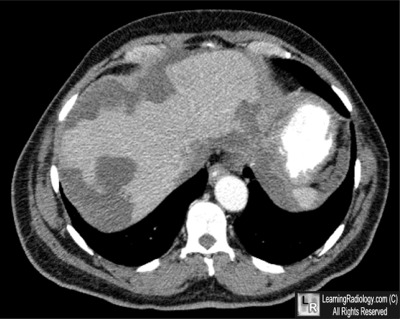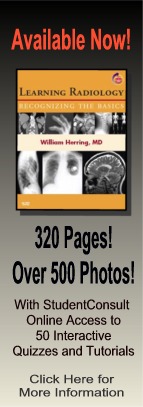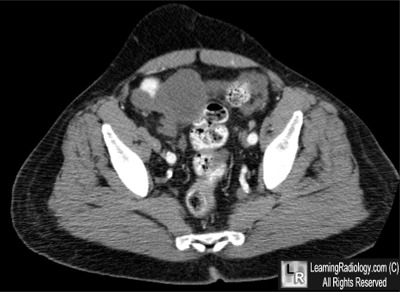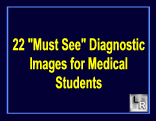| Cardiac | |
|---|---|
| GI | |
| Bone | |
| GU | |
| Neuro | |
| Peds | |
| Faculty | |
| Student | |
| Quizzes | |
| Image DDX | |
| Mobile | |
| |
Misc |
| Videocasts | |
LearningRadiology Imaging Signs
on Twitter
![]()
Follow us on
What is the most likely diagnosis?
- 71 year-old male with right lower quadrant pain

Axial CT scan of upper abdomen
- Cirrhosis
- Liver lacerations
- Metastases from colon carcinoma
- Budd-Chiari syndrome
- Pseudomyxoma peritonei
Additional Image - Axial CT scan of pelvis
![]()
Answer:
.
5. Pseudomyxoma peritonei
.
.
More (Click Discussion Tab)
Pseudomyxoma peritonei
General Considerations
- Diffuse collections of gelatinous material in the abdomen and pelvis and mucinous implants on the peritoneal surfaces
- In almost all cases, it is from a ruptured mucinous tumor of the appendix
- Spectrum from more benign to more malignant findings
- Other causes may include tumors of the large and small bowel, lung, breast, pancreas, stomach, bile ducts, gallbladder, and fallopian tubes/ovary
- More common in females
- Results in mass effect on organs
- Also known as “Jelly Belly
.
This Week
71 year-old male with right lower quadrant pain |
This video podcast reviews the fat pads around the elbow, fractures of the distal humerus and proximal radius and ulna, Nursemaid's elbow, dislocations of the elbow and elbow injuries in children. There is a mini-quiz at the end. |
Some of the fundamentals of interpreting chest images |
The top diagnostic imaging diagnoses that all medical students should recognize according to the Alliance of Medical Student Educators in Radiology |
Recognizing normal and key abnormal intestinal gas patterns, free air and abdominal calcifications |
Recognizing the parameters that define a good chest x-ray; avoiding common pitfalls |
How to recognize the most common arthritides |
| LearningRadiology.com |
is an award-winning educational website aimed primarily at medical students and radiology residents-in-training, containing lectures, handouts, images, Cases of the Week, archives of cases, quizzes, flashcards of differential diagnoses and “most commons” lists, primarily in the areas of chest, GI, GU cardiac, bone and neuroradiology. |



